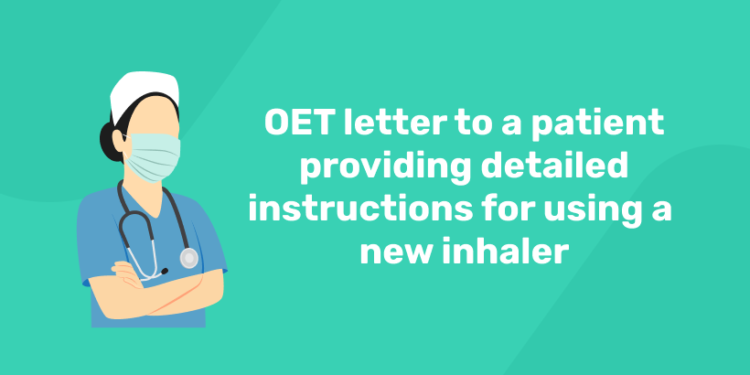Table of Contents
Introduction
The Occupational English Test (OET) is a professional English language test for healthcare professionals like nurses, doctors and pharmacists who want to work in English speaking countries. One of the main parts of the OET is the writing task which involves writing letters to patients, colleagues or other healthcare professionals. An OET letter must show not only command of the English language but also ability to communicate complex medical information clearly and compassionately. In this blog post we will show you how to write an OET letter to a patient giving detailed instructions on how to use a new inhaler. The letter will be structured so that the patient understands the purpose of the inhaler, how to use it and any other considerations related to their condition.
Task
1: What is the primary purpose of a patient’s discharge summary?
When writing an OET letter to a patient, you must put yourself in the patient’s shoes. Your main purpose is to give clear and simple information that the patient can understand and follow. In this case the letter will be to a patient who has been prescribed a new inhaler for their asthma management. The patient may be anxious or confused about the medication especially if they have never used an inhaler before. So it is important to break down the instructions into small steps and use language that is sensitive to the patient’s situation.
To Include
- Introduction: Briefly state the purpose of the letter.
- Inhaler: Name and purpose of the inhaler.
- Step by Step Instructions: Clear instructions on how to use the inhaler.
- Side Effects and Troubleshooting: Possible side effects and what to do if the inhaler doesn’t work.
- Encouragement: Reassure the patient to contact if they have any questions.
Crack OET & Boost Your Healthcare Career!
OET Coaching by Entri App: Get expert guidance, practice with real exam scenarios, and achieve your target score to advance your healthcare career.
Join Now!Example: OET Letter to a Patient
[Your Name] [Your Position] [Your Clinic/Hospital Name] [Address] [City, State, Zip Code] [Email Address] [Phone Number] [Date] [Patient’s Name] [Patient’s Address] [City, State, Zip Code]Dear [Patient’s Name],
You are doing well. Here are the instructions on how to use your new inhaler, [Inhaler Name], which has been prescribed to you to help you manage your asthma better. You must learn how to use this inhaler properly to get the most out of your medicine.
What is [Inhaler Name]?
[Inhaler Name] is a [brief description of the inhaler, e.g., “metered-dose inhaler (MDI)” that delivers a specific dose of medicine into your lungs. This medicine will help open your airways so you can breathe easier during asthma attacks or when you feel short of breath. Use it as directed to get the best results.How to Use Your Inhaler
- Prime the Inhaler: Shake for 5 seconds before use. This will mix the medication.
- Position: Stand or sit up to open your airways. Remove the cap and check the mouthpiece for anything in there.
- Breathe out.
- Inhalation:
- Put the mouthpiece in your mouth and seal your lips around it.
- Press down on the inhaler once and breathe in slowly.
- Hold for 10 seconds to let the medication settle in your lungs.
- Rinse Your Mouth: After using the inhaler, rinse your mouth with water. This will prevent oral thrush which can occur with steroid inhalers.
- Clean the Inhaler: Follow the leaflet instructions.
Side Effects and Troubleshooting
While the [Inhaler Name] is pretty safe, you may experience some of these:
- Throat Irritation: If you get a sore throat after using the inhaler, try rinsing your mouth with water like I mentioned earlier.
- Increased Heart Rate: Some people may feel their heart rate go up after using. If that persists or gets worse, hit me up.
If you don’t feel like the inhaler is helping your symptoms, make sure you’re using it right. If you’re still having trouble breathing or notice big changes in your symptoms, don’t hesitate to reach out.
Support
Remember, managing asthma is a process and you’re not alone. If you have questions or concerns about your new inhaler or your asthma plan, hit me up at [Your Phone Number] or email me at [Your Email Address]. I’ve got your back every step of the way.
Thanks for reading this. I know you got this with your new inhaler.
Sincerely,
[Your Name] [Your Position]Conclusion
Writing a letter to a patient with instructions for a new inhaler is a big task that requires clarity, empathy and professionalism. Follow a structured approach with an introduction, inhaler information, step by step instructions and encouragement and you will be able to convey all the important information to help the patient manage their condition.
If you want to improve your writing skills and excel in OET, join Entri’s OET Coaching for Nurses. With expert guidance and systematic support, Entri’s program will equip you with the tools to succeed in OET writing task and overall language proficiency. The course covers all aspects of OET exam so you will be well prepared to get the scores you need for your nursing career.
Crack OET & Boost Your Healthcare Career!
OET Coaching by Entri App: Get expert guidance, practice with real exam scenarios, and achieve your target score to advance your healthcare career.
Join Now!Frequently Asked Questions
What is an inhaler and how does it work?
An inhaler is a medical device that delivers medicine directly into the lungs. Inhalers are used by people with respiratory conditions like asthma or chronic obstructive pulmonary disease (COPD). There are several types of inhalers, including metered dose inhalers (MDIs), dry powder inhalers (DPIs) and nebulizers.
- MDIs: The medicine is released in aerosol form when you press down on the canister while inhaling.
- DPIs: You need to inhale quickly and deeply to draw the medicine into the lungs.
- Nebulizers: These devices turn liquid medicine into a mist which you inhale through a mouthpiece or mask.
The main purpose of an inhaler is to get the medicine to the airways quickly, for quick relief or long term control of airway inflammation.
How do I use a metered dose inhaler?
- Shake the Inhaler: Before use, shake the inhaler for 5 seconds to mix the medicine.
- Positioning: Stand or sit up straight to get the most out of your lungs. Remove the cap and check the mouthpiece for debris.
- Exhale: Breathe out slowly to empty your lungs.
- Inhalation: Put the mouthpiece between your lips, making sure it’s a tight seal. Press down on the canister while inhaling slowly through your mouth.
- Hold Your Breath: After inhaling, hold your breath for 10 seconds to let the medicine settle in the lungs.
- Rinse Your Mouth: If you’re using a steroid inhaler, rinse your mouth with water after to prevent oral thrush.
- Clean the Inhaler: Clean the inhaler as per the manufacturer’s instructions to keep it working properly.
What are the side effects of using an inhaler?
Inhalers are generally safe and effective but can have some side effects. Common side effects include:
- Throat Irritation: This can happen if the medicine touches your throat.
- Coughing: Some people may cough after using their inhaler.
- Fast Heartbeat: Some medicines can cause a racing heart.
- Oral Thrush: A fungal infection in the mouth, common with steroid inhalers. Rinsing your mouth after use can help prevent this.
If you have any side effects that persist or are severe, see your doctor.
How do OET relate to inhaler instructions for nurses?
The Occupational English Test (OET) tests the English language ability of healthcare professionals including nurses. One of the key parts of the OET is the writing task which often involves writing to patients and may include instructions for using inhalers or other medical devices.
When writing an OET letter nurses must show they can communicate complex medical information clearly and sensitively. This includes step by step instructions for using an inhaler, side effects and encouraging patients to ask questions or seek support.
What to include in an OET letter about an inhaler?
When writing an OET letter about an inhaler include:
- Introduction: Briefly state the purpose of the letter.
- Inhaler: Name of the inhaler and its use.
- Step by Step: Clear and detailed instructions on how to use the inhaler.
- Side effects and Troubleshooting: Tell the patient about possible side effects and what to do if they have a problem.
- Ask for Support: Tell the patient they can contact you with questions or worries.
This will help the patient know how to use the inhaler and feel supported in their treatment.
How do I prepare for the writing task in OET?
Preparing for the OET writing task requires practice and knowledge of the exam format and expectations. Here’s how:
- Know the Format: Get to know the structure of the OET writing task including the types of letters you will be asked to write.
- Write Letters: Write to patients regularly and focus on clarity, sensitivity and task requirements.
- Get Feedback: Get feedback from peers or mentors who are familiar with OET to know what to improve.
- Study Sample Letters: Look at sample OET letters to see how to communicate and language use.
- Enrol in OET Coaching: Consider enrolling in an OET preparation course like Entri’s OET Coaching for Nurses to get expert guidance.
Where can I find resources to learn about inhalers and OET writing?
Here are some resources to help you learn about inhalers and OET writing:
- OET Official Resources: The OET website has sample tests, writing task guidelines and more.
- Medical Books and Journals: These will give you in depth information about inhalers, how to use them and related medical knowledge.
- Online Courses: Entri has courses for OET preparation, writing, speaking and other language skills for healthcare professionals.
- Support Groups and Forums: Talk to other OET candidates.
How can Entri’s OET Coaching for Nurses help me?
Entri’s OET Coaching for Nurses will help aspiring nurses to gain the skills and knowledge to perform well in OET. The program offers:
- Expert Guidance: Learn from instructors who know the OET format and requirements.
- Structured Learning: Follow a set curriculum that covers all aspects of OET, writing, listening, reading, speaking.
- Personalized Feedback: Get feedback on your writing and speaking tasks.
- Mock Tests and Practice Materials: Get access to practice tests that mimic the OET experience and build your confidence and skills.
By joining Entri’s OET Coaching for Nurses you can increase your chances of passing OET and advance your nursing career in English speaking countries.
Why is it important for healthcare professionals to master inhaler instructions?
Mastering inhaler instructions is important for healthcare professionals especially nurses as it affects patient safety and health outcomes. Clear communication about inhaler usage can:
- Patient Understanding: Patients who get clear instructions are more likely to use their inhalers properly and manage their respiratory conditions better.
- Reduce Hospital Admissions: Proper use of inhaler can reduce asthma attacks and hospital visits and overall patient health.
- Build Trust: When healthcare providers communicate well with patients it builds trust and encourages patients to be more involved in their treatment.
In short, clear communication about inhaler usage is an essential skill for healthcare providers for better patient care and outcomes.
What should I do if I have more questions about inhalers or the OET?
If you have further questions about inhalers or the OET, consider the following options:
- Consult Your Healthcare Provider: For inquiries related to specific inhalers or respiratory conditions, your healthcare provider can offer personalized advice and information.
- Reach Out to OET Preparation Courses: Inquire with OET coaching programs like Entri for guidance on the exam format, preparation strategies, and specific writing tasks.
- Join Online Forums: Engage with communities of healthcare professionals preparing for the OET. These forums can provide valuable insights and support.











